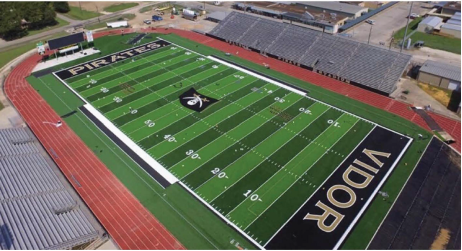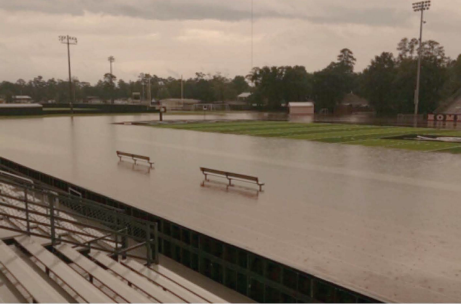Synthetic Turf Justifies Its Cost
Insights from BOSCA Sponsor CEI Engineering

One of the biggest questions asked about synthetic turf is can it endure in heavy rains and flood prone areas? The following case study answers this exact question of how synthetic turf addressed the needs of a school that was continually subjected to an abundance of rainfall and multiple natural disasters.
Vidor High School, located 90 miles east of Houston, saw the wrath of Hurricane Harvey and Tropical Storm Imelda, both of which left the field beneath floodwaters. The difference in these two storms is immediately prior to Imelda, Vidor completed the process of installing granular-infill synthetic turf.
As a result of Vidor’s very soft subgrade and high groundwater table, the school district looked at the standard design of granular-infill synthetic turf, but this type of turf involves drying and compacting the subgrade soils and then capping them with an impermeable pond liner to prevent water from reaching the subgrade. Thus, the integrity of this design relies wholly upon preventing water from reaching the subgrade. In low lying areas such as Vidor, the possibility of the groundwater table rising up from beneath is common, even anticipated, when flooding occurs.

The standard design was not enough for Vidor. They needed a subgrade that could both breathe and allow groundwater to rise and lower without trapping water beneath a pond liner.
The solution was one that had been previously used at McNeese State University and the University of Louisiana at Lafayette where bowl-type stadium designs positioned field surfaces that sit lower than the water table. For these CEI Engineering provided designs using rock structural base layers with cement stabilized subgrade layers that were capped with permeable geotextile fabric. This design provides a subgrade that does not lose strength when saturated and is permeable; allowing groundwater to rise and recede naturally without trapping water.
Groundwater was not the only concern for Vidor's field. Hurricane Harvey proved that the field needed to be able to survive a flood event. The permeable subgrade design would enable the foundation to weather such a storm, but the turf system needed to be taken care of as well. Granular-infill synthetic turf is a stable surface, but it incorporates BB sized particles of crumb rubber and sand that are prone to displacement when submerged.
To deal with this, CEI specified a turf system that would incorporate a high face-weight value of turf fiber and a combination of monofilament fibers and LSR (slit-film) fibers that would provide a field to encapsulate the granular infill from the onset. Little did we know at the time of design that it would be put to test so soon! Less than two weeks after Vidor's field reached substantial completion, Tropical Storm Imelda struck.

Although this storm was not as vast reaching as Harvey, for Vidor and other Gulf areas the impact was the same or even worse. Much of Vidor, including the stadium, was again under water. How did it weather? The school and the community had countless things to worry about, but the stadium field was not one of them. Just one day after flood waters receded, the team was able to resume use of the field with no substantial issues or damage, only minor cleaning and grooming. School officials were able to place their focus where it belonged - on their campuses and community.
If the Vidor field had been grass, it would have been too wet to use, costing the school significant revenue from gate fees and concessions that they plan on as part of their annual budget. The school would have had to relocate their events or risk additional damage to the field if used, causing substantial losses in the short and long term.
"I absolutely believe what is underneath the turf and the base foundation is the most important part of the construction of the athletic field and the synthetic turf. Although the field has only been in use for a little over a month. we have seen many rainfall events including flood, and the field has remained in excellent shape because of the subgrade and drainage system that was provided by the civil engineer," said David Croak, Assistant Superintendent of Business & Operations at Vidor ISD.
While the costs of constructing and maintaining a grass field, over time, are similar to that of a synthetic turf field, turf fields offer a much greater return on investment in many ways, but in particular the reliability of the field that students, coaches, and the community can count on.
Need help with a project on your campus? Visit https://ceieng.com/industries/outdoor-sports-facilities/ to learn more about how CEI Engineering can help.

